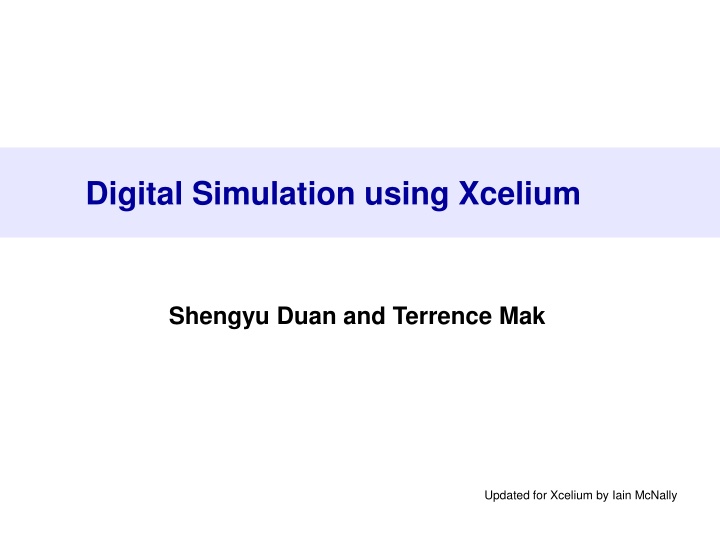
Digital Simulation Using Xcelium Lab Instructions
Explore the step-by-step guide for conducting digital simulations using Xcelium simulator at the School of Electronics and Computer Science, University of Southampton, UK. Learn about setting up the simulator, managing design directories, SDF annotation, timescale specifications, and running simulations for verifying the functionality of a multiplier circuit.
Download Presentation

Please find below an Image/Link to download the presentation.
The content on the website is provided AS IS for your information and personal use only. It may not be sold, licensed, or shared on other websites without obtaining consent from the author. If you encounter any issues during the download, it is possible that the publisher has removed the file from their server.
You are allowed to download the files provided on this website for personal or commercial use, subject to the condition that they are used lawfully. All files are the property of their respective owners.
The content on the website is provided AS IS for your information and personal use only. It may not be sold, licensed, or shared on other websites without obtaining consent from the author.
E N D
Presentation Transcript
Digital Simulation using Xcelium Shengyu Duan and Terrence Mak Updated for Xcelium by Iain McNally
Digital Simulations Lab Instructions For this lab you will need: 1. A post-layout Verilog net list of the design - obtained from place and route lab (wrap_qmults_final.v) 2. A Standard Delay Format file of the design - again, from place and route (wrap_qmults_func_max.sdf) 3. A Verilog testbench - the same as in synthesis lab (wrap_qmults_stim.sv) 2 School of Electronics and Computer Science, University of Southampton, UK
Design Directory Management 1. Inside your design directory create a sub-directory called extracted 2. Copy the design files into extracted ams_demo extracted place_and_route gate_level constraints synthesis behavioural cp place_and_route/wrap_qmults_final.v extracted/wrap_qmults.v cp place_and_route/wrap_qmults_func_max.sdf extracted/ cp behavioural/wrap_qmults_stim.sv extracted/ 3 School of Electronics and Computer Science, University of Southampton, UK
Introduction The simulator we are going to use in this lab is Cadence Xcelium (xmverilog) Before we run the simulation, there are some modifications you need to make 4 School of Electronics and Computer Science, University of Southampton, UK
SDF Annotation In order to simulate your design with correct delays, you need to annotate the .sdf file, in the testbench: Make sure you annotate the .sdf for the right instance 5 School of Electronics and Computer Science, University of Southampton, UK
Timescale xmverilog expects all modules to have timescales specified (whether or not any delays are used in the module). For the wrap_qmults.v Verilog file, we must set a default timescale using following xmverilog option: +xmtimescale+<timeunit>/<timeprecision> 6 School of Electronics and Computer Science, University of Southampton, UK
Run Simulation Now you can simulate your design by following command: xmverilog +naccess+r +xmtimescale+1ns/10ps -f /opt/cad/designkits/ams/v410/verilog/c35b4/verilogin.inc wrap_qmults_stim.sv wrap_qmults_final.v The circuit under test is a multiplier. Thus the functionality can be easily verified by observing the waves. 7 School of Electronics and Computer Science, University of Southampton, UK
